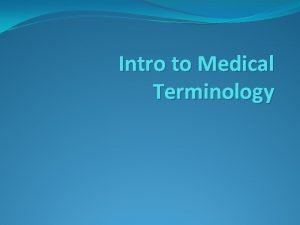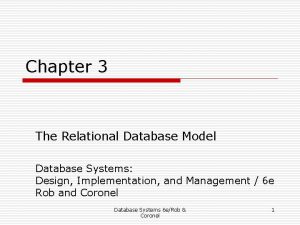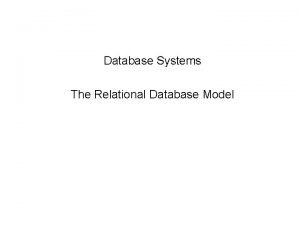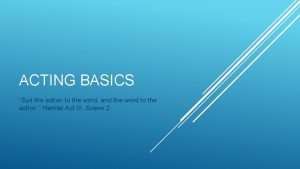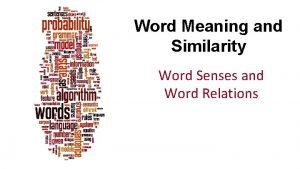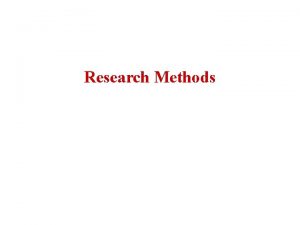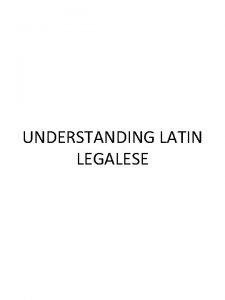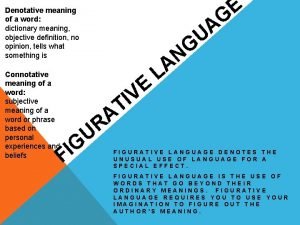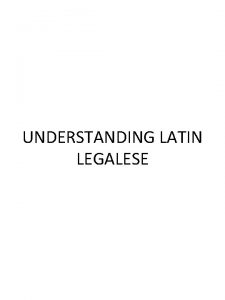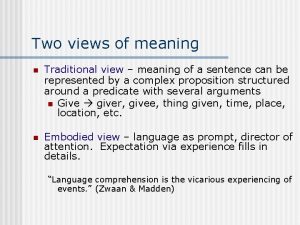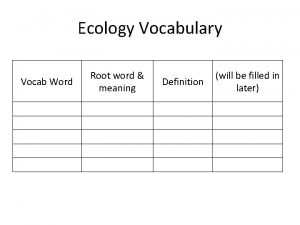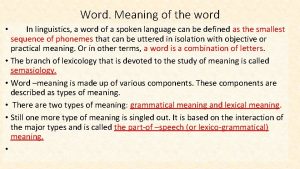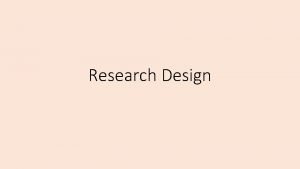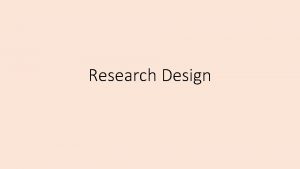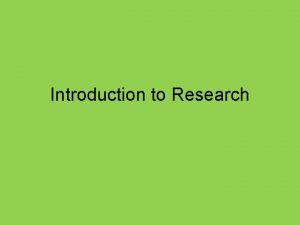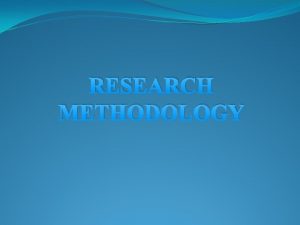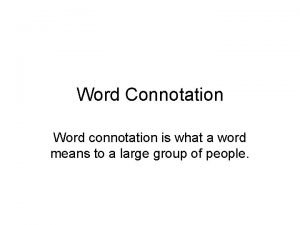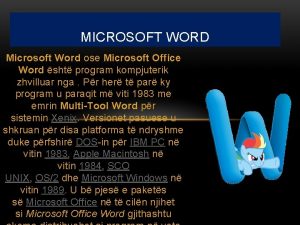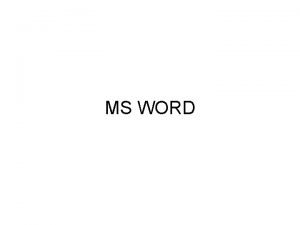MEANING The word research is composed of two
















































- Slides: 48

MEANING: The word research is composed of two syllables, re and search. Re is a prefix meaning again, anew or over again search is a verb meaning to examine closely and carefully, to test and try, or to probe. TOGETHER THEY FORM A NOUN MEANING – ØA systematic and patient study or investigation in some field of knowledge, undertaken to discover or establish facts and principles…. . Webster’s new world dictionary, third college edition. ØResearch is a structured enquiry that utilizes acceptable scientific methodology to solve problems and create new knowledge that is generally applicable. ØResearch is an endeavour to discover answers to intellectual and practical problems through the application of scientific method. Ø“Research is a systematized effort to gain new knowledge”……. Redman and Mory. ØResearch is the systematic process of collecting and analyzing information (data) in order to increase our understanding of the phenomenon about which we are concerned or interested. Dissertation 2011 RESEARCH INTRODUCTION

COMPONENTS OF RESEARCH: ØTHEORY : 1. A systematic statement of principles involved. 2. A formulation of apparent relationships or underlying principles of certain observed phenomena. ØMETHOD : 1. A way of doing anything, procedure, process. ØEPISTEMOLOGY : 1. To understand, 2. To study of nature, sources and limits of knowledge. Dissertation 2011 Theory Method Epistemology

OBJECTIVES OF RESEARCH : The purpose of research is to discover answers through the application of scientific procedures. ØThe objectives are: ØTo gain familiarity with a phenomenon or to achieve new insights into it – ØExploratory or Formulative Research. ØTo portray accurately the characteristics of a particular individual, situation or a group – Descriptive Research. ØTo determine the frequency with which something occurs or with which it is associated with something else – Diagnostic Research. ØTo test a hypothesis of a causal relationship between variables – Hypothesis-Testing Research. Dissertation 2011

THE PROCESS OF RESEARCH : REVIEW-NARROW DOWN-FOCUS DEFINE TOPIC FORMULATE HYPOTHESIS DESIGN METHODOLOGY LITERATURE REVIEW Dissertation 2011 COLLECTION OF DATA/ INFORMATION ANALYSIS/ SYNTHESIS GROUPING, SEQUENCING AND CATEGORISING THE AVAILABLE DATA CONCLUSION/ INFERENCE – WRITE A REPORT

Research techniques refer to the behaviour and instruments we use in performing research operations such as making observations, recording data, techniques of processing data and the like. Research methods refer to the behaviour and instruments used in selecting and constructing research technique.

v. CHARACTERISTIC OF RESEARCH: v. Research is based upon observable experience or empirical evidence. v. Research demands accurate observation and description. v. Research involves gathering new data from primary sources or using existing data for a new purpose. v. Research activities are characterized by carefully designed procedures. v. Research requires expertise i. e. , skill necessary to carryout investigation, search the related literature and to understand analyze the data gathered. v. Research is objective and logical – applying every possible test to validate the data collected and conclusions reached. v. Research is carefully recorded and reported. v. Research requires courage. v. Research is characterized by patient and unhurried activity. v. Research involves the quest for answers to unsolved problems. Dissertation 2011

CRITERIA OF A GOOD RESEARCH: v v v Purpose clearly defined. Research process detailed. Research design thoroughly planned. High ethical standards applied. Limitations frankly revealed. Adequate analysis for decision maker’s needs. v Findings presented unambiguously. v Conclusions justified. v Researcher’s experience reflected. NEED FOR RESEARCH ------------- Dissertation 2011 QUALITIES OF A GOOD RESEARCH: Systematic Logical Empirical Replicable Creative Use of multiple methods v v v EXPLORATION DESCRIBE DIAGNOSE HYPOTHESIS INDUCTIONS AND DEDUCTIONS

TYPES OF RESEARCH: Research can be classified from three perspectives: I. Application of research study II. Objectives in undertaking the research III. Inquiry mode employed Application: From the point of view of application, there are two broad categories of research: - pure research and - applied research. Pure research involves developing and testing theories and hypotheses that are intellectually challenging to the researcher but may or may not have practical application at the present time or in the future. The knowledge produced through pure research is sought in order to add to the existing body of research methods. Applied research is done to solve specific, practical questions; for policy formulation, administration and understanding of a phenomenon. Dissertation 2011

Objectives: From the viewpoint of objectives, a research can be classified as -descriptive -correlational -explanatory -exploratory Descriptive research attempts to describe systematically a situation, problem, phenomenon, service or programme, or provides information about , say, living condition of a community, or describes attitudes towards an issue. Correlational research attempts to discover or establish the existence of a relationship/ interdependence between two or more aspects of a situation. Explanatory research attempts to clarify why and how there is a relationship between two or more aspects of a situation or phenomenon. Exploratory research is undertaken to explore an area where little is known or to investigate the possibilities of undertaking a particular research study (feasibility study/ pilot study). Dissertation 2011

Inquiry Mode: From the process adopted to find answer to research questions – the two approaches are: - Structured approach -Unstructured approach Structured approach: The structured approach to inquiry is usually classified as quantitative research. Here everything that forms the research process- objectives, design, sample, and the questions that you plan to ask of respondents- is predetermined. Unstructured approach: The unstructured approach to inquiry is usually classified as qualitative research. This approach allows flexibility in all aspects of the research process. It is more appropriate to explore the nature of a problem, issue or phenomenon without quantifying it. Dissertation 2011

Descriptive vs Analytical Research is primarily concerned with testing hypothesis Descriptive Research is a fact finding investigation which is aimed at describing the and specifying and interpreting relationships, characteristics of individual, situation or a by analyzing the facts group (or) describing the state of affairs as it or information already available. exists at present. Applied vs Fundamental Research Applied Research or Action Research is carried out to find solution to a real life problem requiring an action or policy decision. Dissertation 2011 Fundamental Research which is also known as basic or pure research is undertaken for the sake of knowledge without any intention to apply it in practice. It is undertaken out of intellectual curiosity and is not necessarily problem-oriented.

Conceptual vs Empirical Research: Conceptual Research is generally used by philosophers and thinkers to develop new concepts or to reinterpret existing ones. Empirical Research is a data based research which depends on experience or observation alone. It is aimed at coming up with conclusions without due regard for system and theory. Quantitative vs Qualitative Research Quantitative Research is employed for measuring the quantity or amount of a particular phenomena by the use of statistical analysis. Dissertation 2011 Qualitative Research is a non-quantitative type of analysis which is aimed at finding out the quality of a particular phenomenon.

Some other type of research are – One-time Research – Research confined to a single time period. Longitudinal Research – Research carried on over several time periods. Diagnostic Research – It is also called clinical research which aims at identifying the causes of a problem, frequency with which it occurs and the possible solutions for it. Exploratory Research – It is the preliminary study of an unfamiliar problem, about which the researcher has little or no knowledge. It is aimed to gain familiarity with the problem, to generate new ideas or to make a precise formulation of the problem. Hence it is also known as formulative research. Dissertation 2011

A broad categorization of the types of methodology/objectives may help the student in defining and focusing on the topic of the study. The categories that can be adapted for conducting the study are classified as – v. Definition or redefinition v. Documentation v. Comparison v. Compilation v. Evolution v. Evaluation v. Feasibility or recommendation Dissertation 2011

Literature Review v Literature Review is the documentation of a comprehensive review of the published and unpublished work from secondary sources of data in the areas of specific interest to the researcher. v The main aim is to find out problems that are already investigated and those that need further investigation. PURPOSE OF LITERATURE REVIEW v v v To gain a background knowledge of the research topic. To identify the concepts relating to it, potential relationships between them and to formulate researchable hypothesis. To identify appropriate methodology, research design, methods of measuring concepts and techniques of analysis. To identify data sources used by other researchers. To learn how others structured their reports. Dissertation 2011

Literature sources v v v Books and Journals Electronic Databases v. Bibliographic Databases v. Abstract Databases v. Full-Text Databases Govt. and Industry Reports Internet Research Dissertations / Thesis Note cards v Detailed Information extracted from a printed source is recorded on the note cards. Recording of literature sources v The most suitable method of recording notes is the card system. v The recording system involves use of two sets of cards: v Source cards (3”x 5”) – used for noting bibliographic information. v Note cards (5”x 8”) – used for actual note taking. Source cards v v v It is desirable to note a single fact or idea on each card, on one side only. Dissertation 2011 Source Cards can be coded by a simple system in order to relate them to the corresponding note cards. Marking the letter ‘B’ or ‘J’ or ‘R’ (B=Books, J=Journal, R=Report) on the left hand top corner.

Evaluating the text: When reading a text, it is important to ask yourself questions about the value of the text. Is this text fact or opinion? If fact, is it true? If opinion, do I agree? Can this writer be trusted? Having decided that a text is reliable, a student must read and understand as much as necessary for the needs of the essay. Understanding a text is not just a matter of vocabulary; the reader needs to find out the writer’s intentions. Is the writer aiming to inform, persuade, describe or entertain? The answer to this question may affect the way a student uses the material. This may be called as the tone. Although it can be acceptable to use articles from newspapers, magazines and the internet, which are often more accessible and up to date, in academic work students need to be aware that these sources may have less credibility, and that material written for a wider readership tends to be less detailed.

Note making – In note-making it is necessary to identify the key points in the text for your purpose. When preparing to write an essay you may be concerned with only one aspect of a text, so your key points should relate only to the topic you are examining. Paraphrasing involves changing a text so that it is quite dissimilar to the source yet retains all the meaning. This skill is useful in several areas of academic work, but this unit focuses on using paraphrasing in note-making and summary writing. Effective paraphrasing is vital in academic writing to avoid the risk of plagiarism. Techniques of paraphrasing a) Changing vocabulary b) Changing word class c) Changing word order

Ancient Egypt collapsed in about 2180 BC. Studies conducted of the mud from the River Nile showed that at this time the mountainous regions which feed the Nile suffered from a prolonged drought. This would have had a devastating effect on the ability of Egyptian society to feed itself. a) The sudden ending of Egyptian civilisation over 4, 000 years ago was probably caused by changes in the weather in the region to the south. Without the regular river flooding there would not have been enough food. b) Research into deposits of the Egyptian Nile indicate that a long dry period in the mountains at the river’s source may have led to a lack of water for irrigation around 2180 BC, which was when the collapse of Egyptian society began. a) Changing vocabulary: studies > research society > civilisation mud > deposits b) Changing word class: Egypt (n. ) > Egyptian (adj. ) mountainous regions (adj. + n. ) > in the mountains c) Changing word order: Ancient Egypt collapsed > the collapse of Egyptian society began

Evaluate the following passages in a similar way. First underline facts and opinion, then decide if the text as a whole is trustworthy. London is an ideal city for young students. Britain’s lively capital, with a population of two million, is the perfect place to live and study. Cheap, comfortable accommodation is always available, and transport is provided by the clean and reliable underground system. Another advantage is the friendly citizens, who are well-known for their custom of stopping to chat with strangers. Overall, London is probably the best place in the world to study English. Global warming affects most people in the world, especially those living in low-lying areas near the sea. It has been predicted that the melting of polar ice may cause the sea to rise by as much as twelve metres by 2050. This would cause flooding in many major coastal cities, such as Tokyo. It has been suggested that the best solution to this problem may be for mankind to become amphibious, like frogs. It is argued that life was originally found in the sea, and so it would merely be a return to our original habitat.

THE PROCESS OF RESEARCH : REVIEW-NARROW DOWN-FOCUS DEFINE TOPIC FORMULATE HYPOTHESIS DESIGN METHODOLOGY LITERATURE REVIEW Dissertation 2011 COLLECTION OF DATA/ INFORMATION ANALYSIS/ SYNTHESIS GROUPING, SEQUENCING AND CATEGORISING THE AVAILABLE DATA CONCLUSION/ INFERENCE – WRITE A REPORT

1. RESEARCH PROBLEM – Steps in formulation of a research problem : Working through these steps presupposes a reasonable level of knowledge in the broad subject area within which the study is to be undertaken. Without such knowledge it is difficult to clearly and adequately ‘dissect’ a subject area. Step 1 Identify a broad field or subject area of interest to you. Step 2 Dissect the broad area into sub areas. Step 3 Select what is of most interest to you. Step 4 Raise research questions. Step 5 Formulate objectives. Step 6 Assess your objectives. Step 7 Double check. Dissertation 2011

What is a research problem? Defining Problem, Results in Clear Cut Research Objectives v The term ‘problem’ means a question or The objectives - refers to the questions to be issue to be examined. The first step in the research process – definition answered through the study. They indicate what we are trying to get from the study or of the problem involves two activities: the expected results / outcome of the study. Identification / Selection of the Problem Formulation of the Problem v There are two ways of stating problem: v 1)Posting question / questions 2)Making declarative statement / statements Dissertation 2011 v Research Objectives should be clear and achievable, as they directly assist in answering the research problem. The objectives may be specified in the form of either statements or questions. Generally, they are written as statements, using the word “to”. (For example, ‘to discover …’, ‘to determine …’, ‘to establish …’, etc. )

● write down the statement of research problem This is the most important part of the proposal and should include: 1 Identification of the objects of study. What buildings, which architects, which cities and/or whose films do you intend to study? 2 The significance of what you are investigating. What is interesting about it, and what ideas do you intend to pursue? 3 The kind of approach adopted. How are you exploring and assessing the subject, and with what methodology? Hypothesis v Research problem Hypothesis is an assumption, that can be v A problem is a broad question/issue which cannot be directly tested. A tested and can be proved to be right or problem can be scientifically investigated wrong. after converting it into a form of hypothesis.

2. RESEARCH TITLE – Writing down the title – Try to be as specific as possible about what you are actually going to look at. ‘Racialism and architecture’ or ‘Abjection and architecture’ Instead - ---------------‘Abjection and Architecture: the Migrant House in Multicultural Australia’. Australia Abjection – from ‘’abject’’ meaning degraded, miserable; of the lowest degree; wretched; to throw away. This Dream Upon the Water: the Representation of a City in Literature – Venice A Speculative Investigation into the Sacred and Aesthetic Principles of Alexander ‘Greek’ Thomson’s Architecture, with particular reference to St. Vincent Street Church Dissertation 2011

3. RESEARCH METHODOLOGY – Dissertation 2011

4 ACADEMIC CONTEXT. Who else has written about this subject already, and what kinds of things have they said? How does your proposed study differ from theirs? 5 CONTENTS LIST. You should list here the titles of each of the main ‘chapters’ of your dissertation. 6 SOURCES. You need to state here where you are getting your information from. List the main libraries, archives, key texts, people, buildings etc. that are of use to your project. 7 TIMETABLE. Give some indication of time. How far have you progressed with the work? When will the rest be done? If there are key events which need to take place – such as an interview, an art event, or a research field trip – make sure to identify these also along with intermediate submission dates. Dissertation 2011

PROCESS OF RESEARCH – Identifying Variables: In a research study it is important that the concepts used should be operationalised in measurable terms. For example: - Food in this restaurant is excellent. - The middle class in India is getting more prosperous. When people express these feelings or preferences, they do so on the basis of certain criteria in their minds. Their judgement is based upon indicators that lead them to conclude and express that opinion.

The definition of a variable: An image, perception or concept that can be measured – hence capable of taking on different values- is called a variable. The difference between a concept and a variable: Concepts are mental images or perceptions and therefore their meaning varies markedly from individual to individual. A concept cannot be measured whereas a variable can be subjected to measurement by crude/refined or subjective/objective units of measurement. It is therefore important for the concept to be converted into variables. Concept Variable • Excellent gender (male/female) • High achiever age (x years y months) • Rich weight ( --kg) • Satisfaction height ( -- cms) • Domestic violence religion (Catholic, Hindu) Concepts, indicators and variables: If you are using a concept in your study, you need to consider how it will be measured. For this, you need to identify indicators- a set of criteria reflective of the concept which can then be converted into variables. The choice of indicators for a concept might vary with researchers, but those selected must have a logical link with the concept.

MEASUREMENT TECHNIQUES FOR RESEARCH. …………………………………… Types of measurement scales: Measurement is central to any enquiry. The greater the refinement in the unit of measurement of a variable, the greater the confidence, other things being equal, one can place in the findings. • Nominal or classificatory scale • Interval scale • Ordinal or ranking scale • Ratio scale The nominal or classificatory scale: A nominal scale enables the classification of individuals, objects or responses into subgroups based on a common/shared property or characteristic. A variable measured on a nominal scale may have one, two or more subcategories depending upon the extent of variation. For example, the variable “gender "can be classified into two sub-categories: male and female. The interval scale: An interval scale has all the characteristics of an ordinal scale. In addition, it uses a unit of measurement with an arbitrary starting and terminating points. For example, Celsius scale: 0*C to 100*C Attitudinal scales: 10 -20, 21 -30, 31 -40 etc

The ordinal or ranking scale: Besides categorizing individuals, objects, responses or a property into subgroups on the basis of common characteristic, it ranks the subgroups in a certain order. They are arranged either in ascending or descending order according to the extent a subcategory reflects the magnitude of variation in the variable. For example, ‘income’ can be measured either quantitatively (in rupees and paise) or qualitatively using subcategories ‘above average’, ‘average’ and ‘below average’. The ‘distance’ between these subcategories are not equal as there is no quantitative unit of measurement. ‘Socioeconomic status’ and ‘attitude’ are other variables that can be measured on ordinal scale. The ratio scale: A ratio scale has all the properties of nominal, ordinal and interval scales plus its own property the zero point of a ratio scale is fixed, which means it has a fixed starting point. Since the difference between intervals is always measured from a zero point, this scale can be used for mathematical operations. The measurement of variables like income, age, height and weight are examples this scale. A person who is 40 year old is twice as old as one who is 20 year old.


Non-probability sampling is also known by different names such as deliberate sampling, purposive sampling and judgement sampling. In this type of sampling, items for the sample are selected deliberately by the researcher; his choice concerning the items remains supreme. In other words, under nonprobability sampling the organisers of the inquiry purposively choose the particular units of the universe for constituting a sample on the basis that the small mass that they so select out of a huge one will be typical or representative of the whole. Probability sampling is also known as ‘random sampling’ or ‘chance sampling’. Under this sampling design, every item of the universe has an equal chance of inclusion in the sample. The implications of random sampling (or simple random sampling) are: (a) It gives each element in the population an equal probability of getting into the sample; and all choices are independent of one another. (b) It gives each possible sample combination an equal probability of being chosen.

While developing a sampling design, the researcher must pay attention to the following points: Type of universe: The first step in developing any sample design is to clearly define the set of objects, technically called the Universe, to be studied. The universe can be finite or infinite. In finite universe the number of items is certain, In infinite universe the number of items is infinite, i. e. , we cannot have any idea about the total number of items. The population of a city, the number of workers in a factory and the like are examples of finite universes, whereas the number of stars in the sky, listeners of a specific radio programme, throwing of a dice etc. are examples of infinite universes. Sampling unit: A decision has to be taken concerning a sampling unit before selecting sample. Sampling unit may be a geographical one such as state, district, village, etc. , or a construction unit such as house, flat, etc. , or it may be a social unit such as family, club, school, etc. , or it may be an individual. The researcher will have to decide one or more of such units that he has to select for his study. Source list: It is also known as ‘sampling frame’ from which sample is to be drawn. It contains the names of all items of a universe (in case of finite universe only). If source list is not available, researcher has to prepare it. Such a list should be comprehensive, correct, reliable and appropriate. It is extremely important for the source list to be as representative of the population as possible.

Size of sample: This refers to the number of items to be selected from the universe to constitute a sample. The size of sample should neither be excessively large, nor too small. It should be optimum. An optimum sample is one which fulfils the requirements of efficiency, representativeness, reliability and flexibility. Parameters for deciding the size of sample – Population - researcher must determine the desired precision as also an acceptable confidence level for the estimate. The size of population variance needs to be considered as in case of larger variance usually a bigger sample is needed. The size of population must be kept in view for this also limits the sample size. The parameters of interest in a research study must be kept in view, while deciding the size of the sample. In determining the sample design, one must consider the question of the specific population parameters which are of interest. For instance, we may be interested in estimating the proportion of persons with some characteristic in the population, or we may be interested in knowing some average or the other measure concerning the population. There may also be important sub-groups in the population about whom we would like to make estimates. All this has a strong impact upon the sample design we would accept.

Costs too dictate the size of sample that we can draw. As such, budgetary constraint must invariably be taken into consideration when we decide the sample size. Budgetary constraint: Cost considerations, from practical point of view, have a major impact upon decisions relating to not only the size of the sample but also to the type of sample. This fact can even lead to the use of a non-probability sample. Time and availability/accessibility is also a important factor in deciding the size of sample to be studied. Sampling procedure: Finally, the researcher must decide the type of sample he will use i. e. , he must decide about the technique to be used in selecting the items for the sample. In fact, this technique or procedure stands for the sample design itself. There are several sample designs (explained in the pages that follow) out of which the researcher must choose one for his study. Obviously, he must select that design which, for a given sample size and for a given cost, has a smaller sampling error.

METHODS OF DATA COLLECTION TYPES OF DATA – • The primary data are those which are collected afresh and for the first time, and thus happen to be original in character. • The secondary data, on the other hand, are those which have already been collected by someone else and which have already been passed through the statistical process. Methods of collecting primary data, particularly in surveys and descriptive researches. Important ones are: (i) observation method, (ii) interview method, (iii) through questionnaires, (iv) through schedules, and (v) other methods which include - (a) warranty cards; (b) distributor audits; (c) pantry audits; (d) consumer panels; (e) using mechanical devices; (f) through projective techniques; (g) depth interviews, and (h) content analysis.

The observation method is the most commonly used method specially in studies relating to behavioural sciences. In a way we all observe things around us, but this sort of observation is not scientific observation. Under the observation method, the information is sought by way of investigator’s own direct observation without asking from the respondent. The main advantages of this method are • subjective bias is eliminated, if observation is done accurately. • the information obtained under this method relates to what is currently happening; • it is not complicated by either the past behaviour or future intentions or attitudes. • It is independent of respondents’ willingness to respond as such is relatively less demanding of active cooperation on the part of respondents as happens to be the case in the interview or the questionnaire method. While using this method, the researcher should keep in mind things like: • What should be observed? • How the observations should be recorded? • Or how the accuracy of observation can be ensured? In case the observation is characterised by a careful definition of the units to be observed, the style of recording the observed information, standardised conditions of observation and the selection of pertinent data of observation, then the observation is called as structured observation.

The interview method of collecting data involves presentation of oral-verbal stimuli and reply in terms of oral-verbal responses from respondents. This method can be used through personal interviews and, if possible, through telephone interviews. The chief merits of the interview method are as follows: (i) More information and that too in greater depth can be obtained. (ii) Interviewer by his own skill can overcome the resistance, if any, of the respondents; the interview method can be made to yield an almost perfect sample of the general population. (iii) There is greater flexibility under this method as the opportunity to restructure questions is always there, specially in case of unstructured interviews. (iv) Observation method can as well be applied to recording verbal answers to various questions. (v) Personal information can as well be obtained easily under this method. (vi) Samples can be controlled more effectively as there arises no difficulty of the missing returns; non-response generally remains very low. (vii) The interviewer can usually control which person(s) will answer the questions. This is not possible in mailed questionnaire approach. If so desired, group discussions may also be held. (viii) The interviewer may catch the informant off-guard and thus may secure the most spontaneous reactions than would be the case if mailed questionnaire is used. (ix) The language of the interview can be adopted to the ability or educational level of the person interviewed and as such misinterpretations concerning questions can be avoided. (x) The interviewer can collect supplementary information about the respondent’s personal characteristics and environment which is often of great value in interpreting results.

But there also certain weaknesses of the interview method. Among the important weaknesses, mention may be made of the following: (i) It is a very expensive method, specially when large and widely spread geographical sample is taken. (ii) There remains the possibility of the bias of interviewer as well as that of the respondent; there also remains the headache of supervision and control of interviewers. (iii) Certain types of respondents such as important officials or executives or people in high income groups may not be easily approachable under this method and to that extent the data may prove inadequate. (iv) This method is relatively more-time-consuming, specially when the sample is large and recalls upon the respondents are necessary. (v) The presence of the interviewer on the spot may over-stimulate the respondent, sometimes even to the extent that he may give imaginary information just to make the interview interesting. (vi) Effective interview presupposes proper rapport with respondents that would facilitate free and frank responses. This is often a very difficult requirement.

Collection of data through questionnaires is quite popular, particularly in case of big enquiries. It is being adopted by private individuals, research workers, private and public organisations and even by governments. In this method a questionnaire is sent (usually by post) to the persons concerned with a request to answer the questions and return the questionnaire. A questionnaire consists of a number of questions printed or typed in a definite order on a form or set of forms. The questionnaire is mailed to respondents who are expected to read and understand the questions and write down the reply in the space meant for the purpose in the questionnaire itself. Merits – 1. There is low cost even when the universe is large and is widely spread geographically. 2. It is free from the bias of the interviewer; answers are in respondents’ own words. 3. Respondents have adequate time to give well thought out answers. 4. Respondents, who are not easily approachable, can also be reached conveniently. 5 Large samples can be made use of and thus the results can be made more dependable and reliable.

Demerits – 1. Low rate of return of the duly filled in questionnaires; bias due to no-response is often indeterminate. 2. It can be used only when respondents are educated and cooperating. 3. The control over questionnaire may be lost once it is sent. 4. There is inbuilt inflexibility because of the difficulty of amending the approach once questionnaires have been despatched. 5. There is also the possibility of ambiguous replies or omission of replies altogether to certain questions; interpretation of omissions is difficult. 6. It is difficult to know whether willing respondents are truly representative. 7. This method is likely to be the slowest of all. Before using this method, it is always advisable to conduct ‘pilot study’ (Pilot Survey) for testing the questionnaires and then make necessary alterations or modifications to the questionairre before the actual survey.

Three main aspects of a questionairre – 1. General form: So far as the general form of a questionnaire is concerned, it can either be structured or unstructured questionnaire. Structured questionnaires are those questionnaires in which there are definite, concrete and pre-determined questions. The questions are presented with exactly the same wording and in the same order to all respondents. Resort is taken to this sort of standardisation to ensure that all respondents reply to the same set of questions. The form of the question may be either closed (i. e. , of the type ‘yes’ or ‘no’) or open (i. e. , inviting free response) but should be stated in advance and not constructed during questioning. Structured questionnaires may also have fixed alternative questions in which responses of the informants are limited to the stated alternatives. Thus a highly structured questionnaire is one in which all questions and answers are specified and comments in the respondent’s own words are held to the minimum. When these characteristics are not present in a questionnaire, it can be termed as unstructured or nonstructured questionnaire.

2. The sequence and nature of questions : The question-sequence must be clear and smoothly-moving, meaning thereby that the relation of one question to another should be readily apparent to the respondent, with questions that are easiest to answer being put in the beginning. 3. Question formulation and wording: Each question must be very clear for any sort of misunderstanding. Question should also be impartial in order not to give a biased picture of the true state of affairs. Questions should be constructed with a view to their forming a logical part of a well thought out tabulation plan and the researcher should clearly define the objectives behind each set of questions. All questions should meet the following standards— (a) Should be easily understood; (b) should be simple i. e. , should convey only one thought at a time; (c) should be concrete and should conform as much as possible to the respondent’s way of thinking.

Essentials of a good questionnaire: To be successful, questionnaire should be • short and simple i. e. , the size of the questionnaire should be kept to the minimum. • Questions should proceed in logical sequence moving from easy to more difficult questions. Personal and intimate questions should be left to the end. • Technical terms and vague expressions capable of different interpretations should be avoided in a questionnaire. • Questions may be - dichotomous (yes or no answers), multiple choice (alternative answers listed) or open-ended. The latter type of questions are often difficult to analyse and hence should be avoided in a questionnaire to the extent possible. • There should be some control questions in the questionnaire which indicate the reliability of the respondent. The control questions, introduce a cross-check to see whether the information collected is correct or not. • Questions affecting the sentiments of respondents should be avoided. • Adequate space for answers should be provided in the questionnaire to help editing and tabulation. • There should always be provision for indications of uncertainty, e. g. , “do not know, ” “no preference” and so on. • Brief directions with regard to filling up the questionnaire should invariably be given in the questionnaire itself.


IMPORTANT FOR STUDENTS - v Be punctual. v Be specific. v Ask questions. v Provide for and Allow time for feedback. v Provide drafts in a suitable format. v Use your supervisor. Dissertation 2011

REFERENCES – 1. Dawson, Catherine, 2002, Practical Research Methods, New Delhi, UBS Publishers’Distributors 2. Kothari, C. R. , 1985, Research Methodology- Methods and Techniques, New Delhi, Wiley Eastern Limited. 3. Iain Borden and Katerina Rüedi Ray, second edition 2006, The Dissertation - An Architecture Student’s Handbook, Burlington, Architectural Press. 4. Stephen Bailey, 2004, Academic Writing -A practical guide for students, Routledge. Falmer, Taylor & Francis Group. Dissertation 2011
 Medical word parts
Medical word parts Two-dimensional structure composed of rows and columns
Two-dimensional structure composed of rows and columns Two-dimensional structure composed of rows and columns
Two-dimensional structure composed of rows and columns Carl linnaeus
Carl linnaeus Brazen sonnet
Brazen sonnet Suit the action to the word the word to the action meaning
Suit the action to the word the word to the action meaning Hình ảnh bộ gõ cơ thể búng tay
Hình ảnh bộ gõ cơ thể búng tay Ng-html
Ng-html Bổ thể
Bổ thể Tỉ lệ cơ thể trẻ em
Tỉ lệ cơ thể trẻ em Chó sói
Chó sói Tư thế worms-breton
Tư thế worms-breton Alleluia hat len nguoi oi
Alleluia hat len nguoi oi Môn thể thao bắt đầu bằng chữ f
Môn thể thao bắt đầu bằng chữ f Thế nào là hệ số cao nhất
Thế nào là hệ số cao nhất Các châu lục và đại dương trên thế giới
Các châu lục và đại dương trên thế giới Công thức tiính động năng
Công thức tiính động năng Trời xanh đây là của chúng ta thể thơ
Trời xanh đây là của chúng ta thể thơ Mật thư anh em như thể tay chân
Mật thư anh em như thể tay chân Làm thế nào để 102-1=99
Làm thế nào để 102-1=99 độ dài liên kết
độ dài liên kết Các châu lục và đại dương trên thế giới
Các châu lục và đại dương trên thế giới Thể thơ truyền thống
Thể thơ truyền thống Quá trình desamine hóa có thể tạo ra
Quá trình desamine hóa có thể tạo ra Một số thể thơ truyền thống
Một số thể thơ truyền thống Cái miệng nó xinh thế chỉ nói điều hay thôi
Cái miệng nó xinh thế chỉ nói điều hay thôi Vẽ hình chiếu vuông góc của vật thể sau
Vẽ hình chiếu vuông góc của vật thể sau Nguyên nhân của sự mỏi cơ sinh 8
Nguyên nhân của sự mỏi cơ sinh 8 đặc điểm cơ thể của người tối cổ
đặc điểm cơ thể của người tối cổ Giọng cùng tên là
Giọng cùng tên là Vẽ hình chiếu đứng bằng cạnh của vật thể
Vẽ hình chiếu đứng bằng cạnh của vật thể Fecboak
Fecboak Thẻ vin
Thẻ vin đại từ thay thế
đại từ thay thế điện thế nghỉ
điện thế nghỉ Tư thế ngồi viết
Tư thế ngồi viết Diễn thế sinh thái là
Diễn thế sinh thái là Dạng đột biến một nhiễm là
Dạng đột biến một nhiễm là Thế nào là số nguyên tố
Thế nào là số nguyên tố Tư thế ngồi viết
Tư thế ngồi viết Lời thề hippocrates
Lời thề hippocrates Thiếu nhi thế giới liên hoan
Thiếu nhi thế giới liên hoan ưu thế lai là gì
ưu thế lai là gì Sự nuôi và dạy con của hổ
Sự nuôi và dạy con của hổ Khi nào hổ con có thể sống độc lập
Khi nào hổ con có thể sống độc lập Hệ hô hấp
Hệ hô hấp Từ ngữ thể hiện lòng nhân hậu
Từ ngữ thể hiện lòng nhân hậu Thế nào là mạng điện lắp đặt kiểu nổi
Thế nào là mạng điện lắp đặt kiểu nổi Enzymes are composed of what organic molecule
Enzymes are composed of what organic molecule
